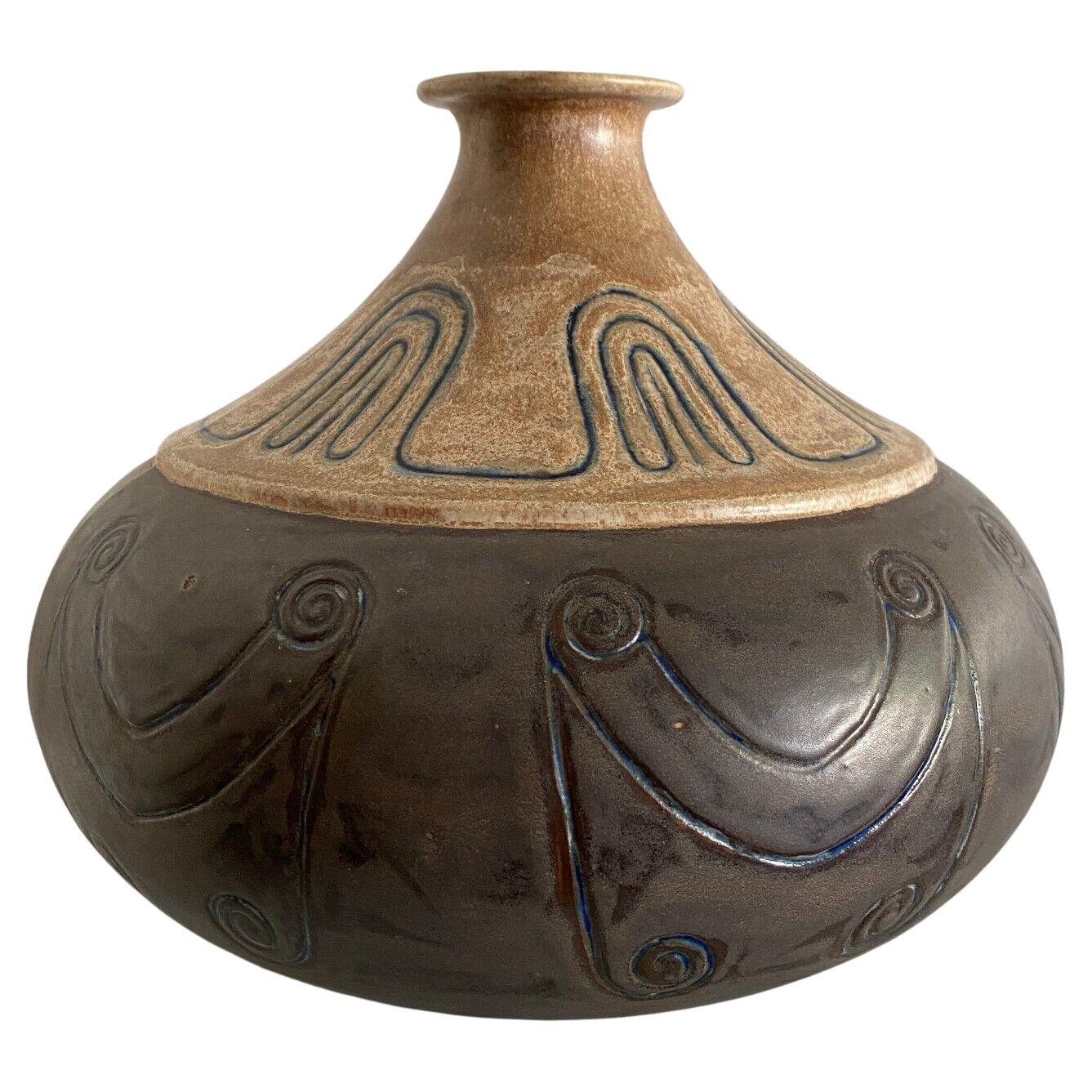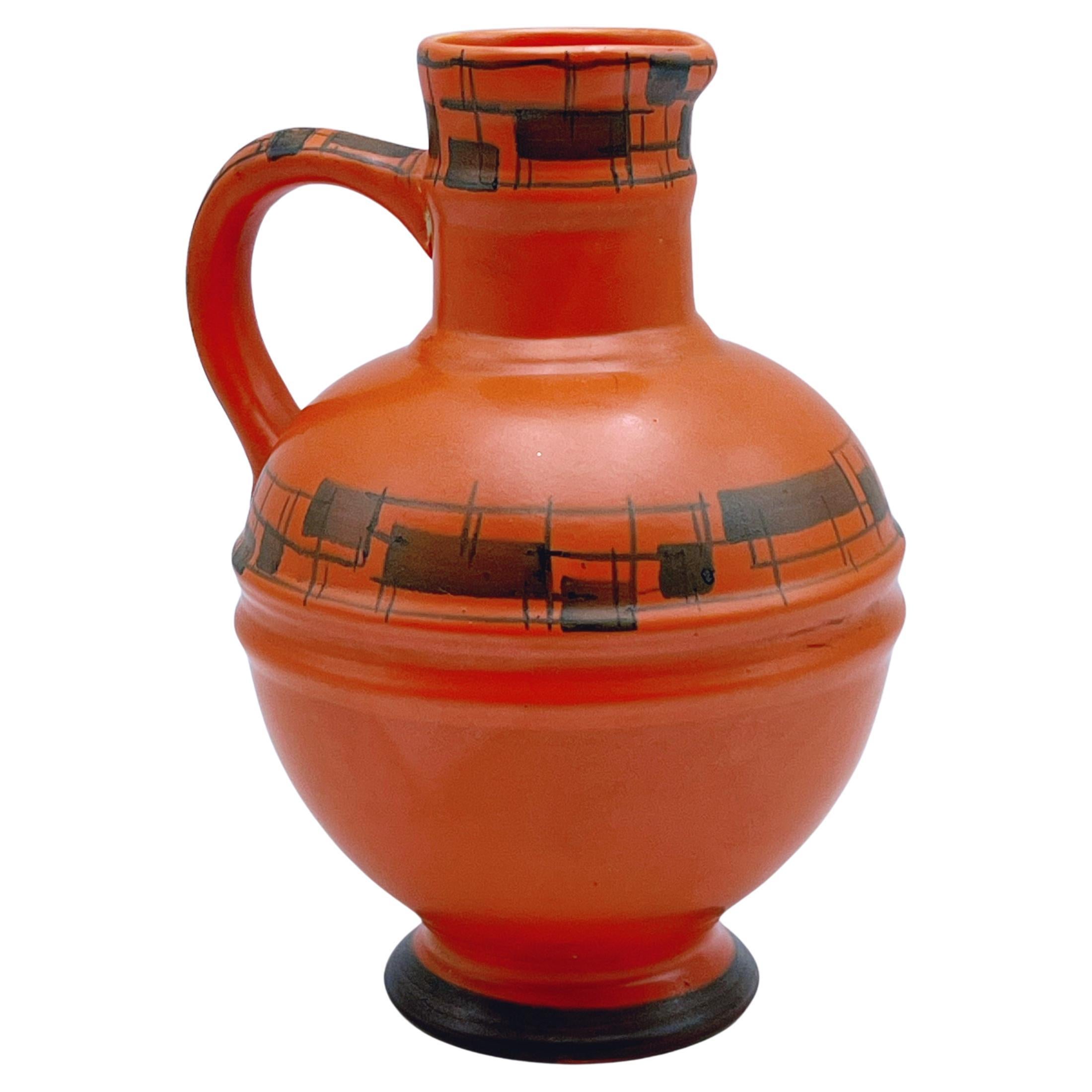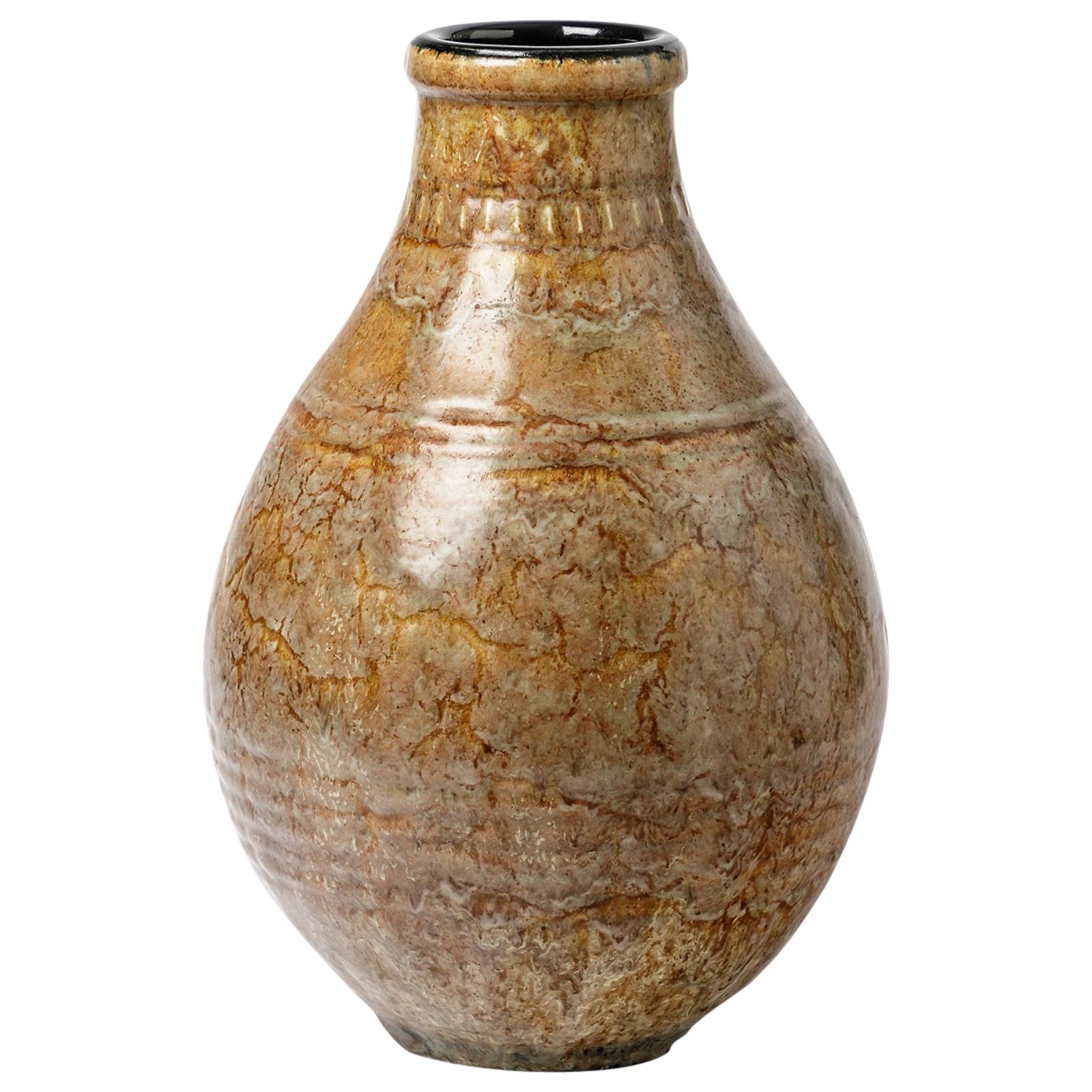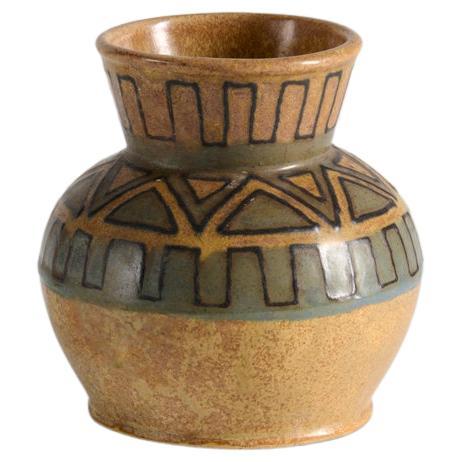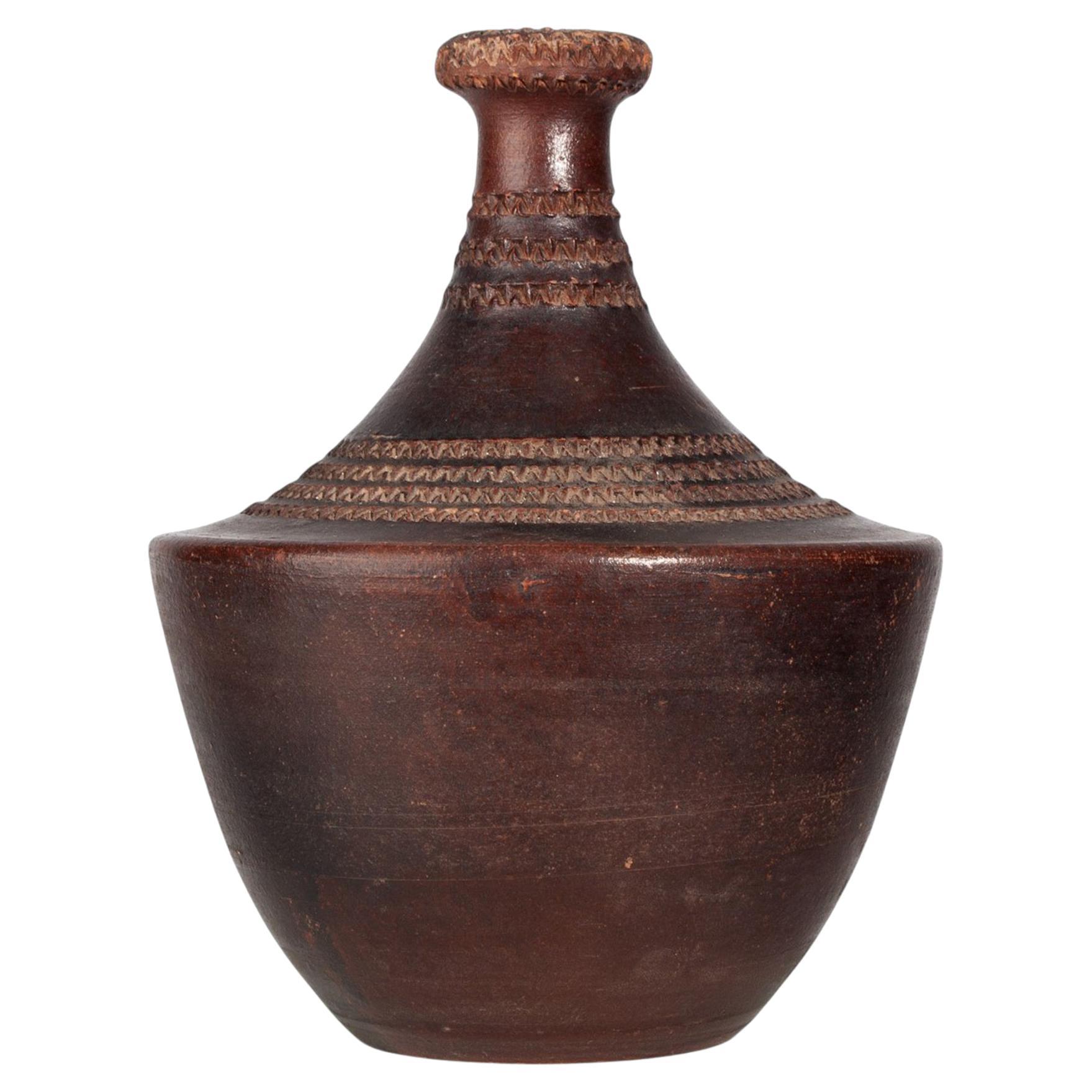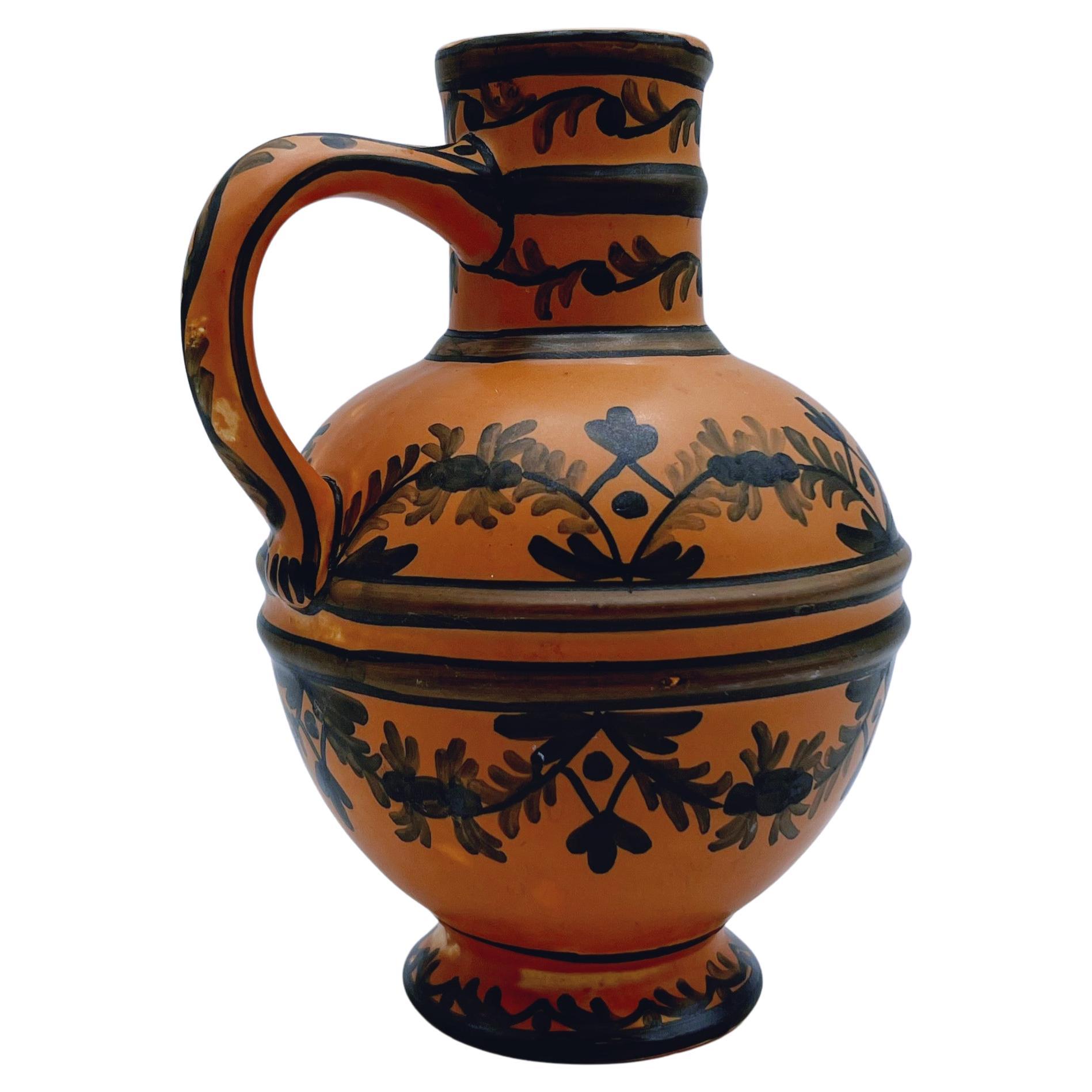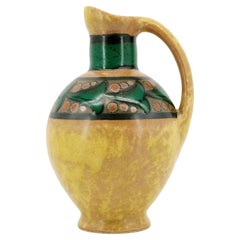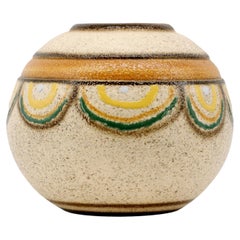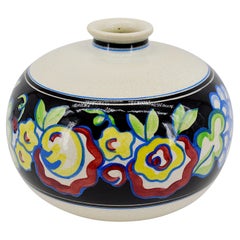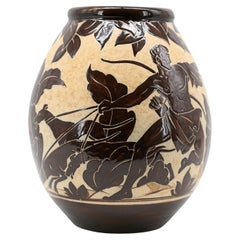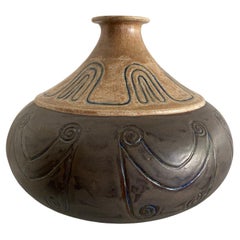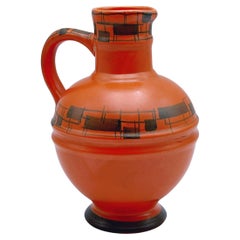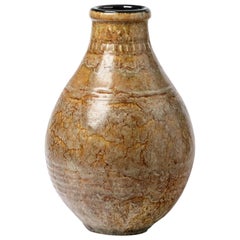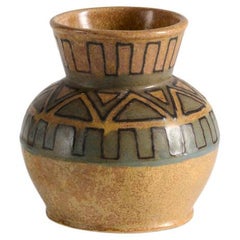Items Similar to ODETTA QUIMPER Art Deco Stoneware Vase, 1920
Video Loading
Want more images or videos?
Request additional images or videos from the seller
1 of 13
ODETTA QUIMPER Art Deco Stoneware Vase, 1920
$3,800
£2,867.76
€3,283.15
CA$5,359.26
A$5,883.80
CHF 3,069.59
MX$71,202.16
NOK 38,472.55
SEK 36,251.26
DKK 24,507.81
About the Item
A stunning French Art Deco stoneware vase by the renowned René Beauclair (1877-1960), produced at ODETTA, Faïencerie de la Grande Maison HB Quimper, France, ca.1920. The vase features the distinctive Shape #512 and is decorated with the rare and sought-after Decor #1321bis, which is a particularly limited design, making this piece all the more unique. With its elegant, geometric form and meticulously executed decoration, this vase exemplifies the sophistication of the Art Deco movement.
Measuring 8.3" (21 cm) in height and 8.1" (20.5 cm) in diameter, this vase is in excellent condition, reflecting the exceptional craftsmanship of its maker. A remarkable and rare example of French Art Deco ceramic art, it would make an impressive addition to any collection.
From 1903, Jules Verlingue, at the head of the Faïencerie de la Madeleine, in Boulogne-sur-Mer, produced stoneware.
In December 1913, a fire destroyed part of the Faïencerie de la Madeleine. The factory being poorly insured, its owner was forced to sell to Boulogne banker Henri Delcourt. Jules Verlingue will remain director of his former establishment. The funds from the sale will be used by him, in association with Louis Delcourt, doctor of law and brother of Henri, to acquire, in 1914, the earthenware factory of his friend Guy de La Hubaudière, in Quimper.
When the Faïencerie HB restarted in 1917, everything was refurbished and equipped.
In 1923, under the impetus of Jeanne Malivel and René-Yves Creston, the “Ar Seiz Breur” (Seven Brothers) movement was born. This group of Breton creators aims to revive Celtic art. suffocated by classic taste, modernizing it and adapting it to everyday life. This period is extremely rich, encouraged of course by the antistical Art Nouveau and Art Deco movements.
The HB Jules Verlingue and Bolloré factory is not lagging behind, thanks to the collaboration of the sculptor René Quillivic, many of whose works today adorn the squares of Breton villages, in memory of the dead of the Great War and the heavy tribute paid by Brittany to this conflict. Breton artists, many of whom live in Paris, find a new motivation, pushed, for some, by a regionalist feeling. Quimper faience is living a great era, probably one of the richest in its history. Artists of solid reputation will come in large numbers to participate in this revival.
The ODETTA brand was registered in 1922. Locmaria is on the banks of the Odet, the river sung by Max Jacob, born a stone's throw from its quays:
The originality of the Odetta production resides, in addition to the creation of new forms, in the technique of decoration employed. Traditionally, the decoration of Quimper faience is carried out by applying ceramic colors, with the touch, on raw enamel or on biscuit. For sandstone. we are faced with a cloisonné process, dear to Longwy. The outline of the decor is traced with manganese, refractory oxide. The reserves thus traced, with a freehand brush or according to the dotted line left by the stencil, are filled with enamels applied by drop, with a brush made of ox ear hair. Enamels to adhere well to the support, contain a decoction of fucus, seaweed with which the coast abounds. This is thanks to the use of enamels. in substitution for colors, that the chromatic palette finds all its power. So for sandstone. the same is true for Quimper earthenware known worldwide for the liveliness of its tones.
The launch of stoneware manufacturing by the Grande Maison will have a rather unexpected consequence. As we have seen, Jules Henriot, the competitor, secured the collaboration of well-known artists through the Breton Regionalist Union. Many of the latter, seduced by the range of possibilities offered by sandstone, as well as by the richness of the material, will abandon Henriot for the Grande Maison. Jules Verlingue becomes alone, in Quimper. able to make artistic pieces in glazed stoneware.
To achieve its objective, the Grande Maison registered the "HB Quimper Odetta" trademark in 1922. The history of sandstone is on the move. The Odetta mark will thus be affixed to all the sandstone pieces, with the exception of the statuettes, where it is replaced by the name of the artist. In principle, the mark is inscribed in black on the bottom of the vase, after the mention "HB Quimper". In principle only, because exceptions are frequent. On the one hand, the name of the artist creating the piece often replaces the brand; on the other hand, some vases, and not the least important ones, have neither the name nor the Odetta mark.
In 1922, Art Deco had almost reached its peak. At HB, we know that Charles Catteau took, since 1907, the artistic direction of Kéramis, in La Louvière. The Mougin brothers have been active for a long time in Nancy. Mayodon exhibited regularly at the Salon des artistes décorateurs from 1920. The possibilities offered by sandstone pottery correspond well to Art Deco trends.
The history of Odetta sandstones is poorly known. It is possible that some pieces were presented at the Intemational Exhibition of Decorative Arts in 1925, without further details. On the other hand, on the HB stand of the Colonial Exhibition of 1931, many sandstone vases, very representative of the entire production, are arranged among other objects, statuettes and dishes, in sandstone and earthenware.
Some forms of Odetta stoneware are similar to those used by many ceramists of the time, and even by coppersmiths. Others, on the other hand, are original. Two prevailing sources of inspiration. The first is of exotic essence: African and Oceanian pottery serves as models, hence these powerful, pot-bellied shapes, with narrow necks, sometimes equipped with handles. The second source is that of artists who want nothing duty to the past: adopted by cubism, revealed in 1907, or by the avant-garde theories of the Bauhaus. They draw surprisingly modern geometric shapes.
Each vase has, in principle - because exceptions are not uncommon - two numbers. The first, usually composed of three digits, designates the shape. The second of four digits, locate the decor. These numbers are painted on the bottom of the vase at the same time as the mark. A tiny "g" is almost always engraved in the clay on this same background, a precaution taken in the workshops to avoid confusion between the biscuits, the same shapes being often used for stoneware and earthenware. Unlike sandstone statuettes.
There is no uniqueness of inspiration in the decor of HB stoneware. It's a good thing, and it perfectly reflects the spirit of Art Deco, more protean than some imagine, drawing inspiration from several sources, but always in search of rigour. And the rigor is perfectly suited to the material of sandstone. Alongside the geometric figures, the decor is sometimes thematic. It can evoke Brittany, its fauna, its flora and its people, but it does not lock itself into regionalism and opens up to the world. Artists willingly emancipate women, with boyish hairstyles, their high heeled shoes inviting to dance the charleston rather than the gavotte. The work of enamels does not resemble the techniques of painting earthenware. The enamels are spread in successive drops, up to the limits of a surface drawn with the help of a black net of manganese oxide, giving the whole a compartmentalised appearance. More rarely. the design is traced in hollow in the dough, before the first firing.
The harmony of the Odetta, beyond the decoration, is due to the richness of the range of enamels. Shiny or matt, depending on the desired effect, they are so original that an informed connoisseur can distinguish at first sight an HB stoneware among other vases from the same period. A shades of ocher and a blue having the depth of that of Sèvres are particularly remarkable. Used in more or less thick layers, the enamel allows moiré effects, which experienced painters will know how to render to perfection.
The realization of the sets requires both experience, dexterity and aesthetic sense. The artists give their instructions to the painters but do not carry out the work themselves. Given the qualities required, only a few people will be entrusted with the execution of the important parts. Each affixing a distinctive sign to the bottom of the vase, it appears that three sculptor painters are, over the years, the talented authors of most of the great pieces. The majority of the small vases and a good half of the important pieces have remained anonymous and, for lack of archives, most will remain so. We can only regret the excess of modesty of their creators, and the little regard that was then made of their talent. There remain those whose signature on the bottom of the vases and in the catalogs of the Grande Maison sheds some light on the story. Their names are Chanteau, Fouillen, Brisson, Garin, Beauclair, Renaud or Roll.
- Creator:HB Quimper Odetta (Maker),René Beauclair (Artist)
- Dimensions:Height: 8.27 in (21 cm)Diameter: 8.08 in (20.5 cm)
- Style:Art Deco (Of the Period)
- Materials and Techniques:
- Place of Origin:
- Period:
- Date of Manufacture:1920
- Condition:
- Seller Location:Saint-Amans-des-Cots, FR
- Reference Number:1stDibs: LU2312343423062
About the Seller
5.0
Platinum Seller
Premium sellers with a 4.7+ rating and 24-hour response times
Established in 2003
1stDibs seller since 2016
497 sales on 1stDibs
Typical response time: <1 hour
- ShippingRetrieving quote...Shipping from: Saint-Amans-des-Cots, France
- Return Policy
Authenticity Guarantee
In the unlikely event there’s an issue with an item’s authenticity, contact us within 1 year for a full refund. DetailsMoney-Back Guarantee
If your item is not as described, is damaged in transit, or does not arrive, contact us within 7 days for a full refund. Details24-Hour Cancellation
You have a 24-hour grace period in which to reconsider your purchase, with no questions asked.Vetted Professional Sellers
Our world-class sellers must adhere to strict standards for service and quality, maintaining the integrity of our listings.Price-Match Guarantee
If you find that a seller listed the same item for a lower price elsewhere, we’ll match it.Trusted Global Delivery
Our best-in-class carrier network provides specialized shipping options worldwide, including custom delivery.More From This Seller
View AllLouis LOURIOUX Stoneware Jug, 1920
By Louis Lourioux
Located in Saint-Amans-des-Cots, FR
French Art Deco stoneware jug by Louis LOURIOUX (Foecy), France, ca.1920. Height : 8.25"(21cm), Width : 5.1"(13cm), Depth : 5.5"(14cm). Wolf stamp at the bottom of the base
Category
Vintage 1920s French Art Deco Vases
Materials
Ceramic, Stoneware
Louis DAGE French Art Deco Stoneware Vase, 1920
By Louis Dage
Located in Saint-Amans-des-Cots, FR
French Art Deco stoneware vase by Louis DAGE (Antony, Paris), France, 1920s. Enamel applications. Height: 8.2"(20.5cm), Diameter: 9.8"(25cm). Excellent condition !
Louis Dage starts...
Category
Vintage 1920s French Art Deco Vases
Materials
Ceramic, Stoneware
French Art Deco Vase at Sainte-Radegonde, 1920
By Sainte Radegonde
Located in Saint-Amans-des-Cots, FR
French Art Deco ceramic vase at Sainte-Radegonde, France, 1920s. Crackle glaze ceramic vase with a wide belt made of strongly stylized flowers and fruits . Height: 8.7"(22cm), Width:...
Category
Vintage 1920s French Art Deco Vases
Materials
Ceramic
Richard LE CORRONE at CIBOURE Large Greek Stoneware Vase, Early 1950s
By Richard Le Corrone, Ciboure
Located in Saint-Amans-des-Cots, FR
Large stoneware vase by Richard Le Corrone at Ciboure, France, early 1950s. High technical quality rotating Greek decor. The stylized rotating scenery depicts Artemis and Apollo hunting with their dogs. Jarraila technique. Height : 11"(28cm), Diameter : 9.45"(24cm). Signed "R. Le Corrone" and stamped "RF Ciboure" under the base.
CIBOURE pottery was founded in 1919 on the Basque coast by Etienne Vilotte (1881-1957), Louis Benjamin Victor Floutier (1882-1936) and a man named LUKAS. In 1922, the date of the formal establishment of the company, Vilotte is the manager. From its inception, the style is clearly defined. A classical orientation, strongly imbued with the antique style and taking advantage of the neo-Greek wave. The characteristics of Art Deco are a source of inspiration as well as the regional style is an influence. The goal is clear: to offer high quality and decorative items whose forms are inherited from the ancient or traditional Basque containers. The sandstone reflects this enthusiasm for this growing area since the late 19th century.
In 1945, Rudolf Fischer bought the pottery on which it imposes its trademark in 1951 - RF CIBOURE - to replace the old - VE CIBOURE -. It will be replaced later by that of his son Max Fischer - MF CIBOURE -. He brings technical and artistic changes such as molding, baking more oxidizing and parts production utilities. This pottery owes its success, in addition to the decorative qualities and originality of its production, to an excellent marketing, particularly among Parisian department stores. Finally we note the names of its principal designers, the first and until 1922: Louis Floutier...
Category
Vintage 1950s French Art Deco Vases
Materials
Ceramic, Stoneware
AMPHORA Art Deco Stoneware Vase, Late 1920s
By Amphora
Located in Saint-Amans-des-Cots, FR
Large Art Deco vase by AMPHORA (Turn Teplitz, Bohemia), Czech Republic, late 1920s. This vase was produced for France. Large vase with two small handles. Rotating enameled Art Deco d...
Category
Vintage 1920s Art Deco Vases
Materials
Stoneware
Gilbert METENIER Tall French Art Deco Stoneware Vase 1920
By Gilbert Metenier
Located in Saint-Amans-des-Cots, FR
French Art Deco stoneware vase by Gilbert METENIER (Gannat), France, ca.1920. " Grand Vase Moderne" (in the catalogue). Tall stoneware vase with a stylizded Art Deco decor. Height : ...
Category
Vintage 1920s French Art Deco Vases
Materials
Ceramic, Stoneware
You May Also Like
Odetta Quimper stoneware vase by Louis Garin (1888-1959)
By Louis Garin
Located in NANTES, FR
This stylized vase is made of enameled stoneware from the Odetta period from the HB Quimper factory. It is signed on the bottom "HB Quimper Garin 1326".
It is a piece in perfect co...
Category
20th Century Vases
Materials
Stoneware
Art Deco Hand-Painted Pitcher Vase by Egersund Faience, Norway, 1930s
Located in Skien, NO
Antique Art Deco-style pitcher vase with a hand-painted underglazed pattern, featuring a primitive Scandinavian/Nordic design. Crafted in faience by Egersund Faience, Norway, circa 1...
Category
Early 20th Century Norwegian Art Deco Planters, Cachepots and Jardinières
Materials
Porcelain, Ceramic, Faience, Pottery
Exceptional Ceramic Vase by Émile Decoeur, circa 1927
By Émile Decoeur
Located in Saint-Ouen, FR
An exceptional ceramic vase by Émile Decoeur.
Perfect original conditions.
Signed under the base,
circa 1927.
Category
20th Century French Art Deco Vases
Materials
Ceramic
HB Quimper Odetta, Vase with Geometric Motif, France, Circa 1920
Located in New York, NY
A small with a wide mouth, this Art Deco vase is glazed in earthy tones with bands of geometric patterns ringing its shoulder and neck.
Signed: HB Quimper Odetta
Category
Vintage 1920s French Mid-Century Modern Vases
Materials
Ceramic
1930s Folk Ceramic Vase with Incised Decorative Patterns by Jean Besnard, France
By Jean Besnard
Located in North Miami, FL
1930s ancient-inspired Art Déco folk ceramic vase with incised decorative patterns by Jean Besnard, France
By: Jean Besnard
Material: ceramic, clay
Technique: cast, pressed, hand-cr...
Category
Vintage 1930s French Art Deco Vases
Materials
Ceramic, Clay
1930s Art Deco Hand-Painted Pitcher Vase by Egersund Faience, Norway
Located in Skien, NO
Primitive Scandinavian/Nordic design antique Art Deco-style pitcher vase in faience with a hand-painted underglazed pattern. Crafted by Egersund Faience in Norway, circa 1930s.
The ...
Category
Early 20th Century Norwegian Art Deco Planters, Cachepots and Jardinières
Materials
Porcelain, Ceramic, Faience
$960 Sale Price
20% Off
More Ways To Browse
Primitive Jug
Rare Aldo Londi
Rare Murano Glass Red
Red Clay Pottery
Roman Amphora
Rosenthal Glass Vases Clear
Royal Copenhagen Crackle Vase
Royal Copenhagen Porcelain White Vase
Ruffled Glass Vase
Russian Gilt Bronze Vase
Schaffenacker Vase
Sevres Cobalt Vase Bronze
Signed Cut Glass Vases
Silver Trophy Vase
Strawberry Vase
Tiara Glass
Tokoname Ware
Tree Trunk Vase
